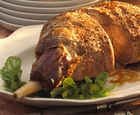|
Greek Entree Roasted Leg of Lamb Not in the history books, but our theory is that the Greeks invented roast leg of lamb along with democracy. It all starts with a savory rub of olive oil, garlic and herbs. Marinade: peel garlic and slice 3 of the cloves into thin slivers. Make little slits in skin of lamb and insert garlic slivers into pockets. Brush or mince remaining 1 garlic clove. Make a paste of crushed garlic, lemon zest, lemon juice, oil herbs and seasonings and rub onto surface of lamb. Let sit, loosely covered, in refrigerator for at least an hour. Roasting: preheat oven to 350. Roast lamb for 1 3/4 - 2 hours, or till meat thermometer registers 140.* Place lamb on a carving board or platter, allowing it to rest for 10-15 minutes before carving. In the meantime, put cornstarch in a little warm water, stirring till dissolved. Add gradually to the pan juices, along with the mint, stirring continually. You may not need to add all of the cornstarch; it depends on how creamy or thick you like your juices. Serve the gravy in a bowl with the lamb. * This is for medium rare. As the meet rests before carving, it will continue to cook, going up by 5 degrees. |
Tips & Glossary You may not have a number of ingredients used in Greek cooking in your spice shelf, but you can find them at Mid-Eastern food stores. So to avoid frustration, make a list of the items you need before trying out the recipes. Filo: aka phyllo, paper-thin sheets of raw, unleavened flour dough. Purchase frozen in most grocery stores and follow directions on package for thawing. When working with a sheet, keep others covered with a damp towel to prevent drying out. Grape Leaves: Grape leaves are sold canned in salted oil. Rinse off the salt before using. If you want, prepare your own: find fresh, tender young leaves and plunge them for 1 minute into boiling water (with 1 or 2 T lemon juice). Then proceed with recipe. After blanching, you can freeze them for later use. Here’s how: blanch as above, dunk in iced water, pat dry with towels, and seal in an air-tight plastic bag. They're safe for 6 months, but use quickly when thawed. Nutmeg: Use small whole nuts and store them, tightly covered, in a dry dark area. Grate what you need using the smallest grating edge or grind in a food processor. What a difference from store bought nutmeg! Pine Nuts: edible seeds of pine trees used in many Greek dishes. Before cooking, release flavor by lightly browning in a heated skillet Skewers: Use metal or wooden skewers for kebobs. If wooden, soak 30 minutes before using to prevent them from catching on fire. Rosewater: distilled from rose petals and used to flavor Mid-Eastern and Asian cooking. You can make your own. But, seriously, why would you? Purchase it at Asian or Mid-Eastern stores. Semolina: aka farina or Cream of Wheat; a coarsely ground wheat grain. You also know it as couscous. If made from durum wheat, it is used to make pasta. Tarama: poor-man's caviar. From carp roe, it is pinkish-orange and is what (along with food dye) gives taramasalata its lovely color. Buy it jarred in Mid-Eastern food stores.
|
Site by BOOM
![]()
LitLovers © 2024

